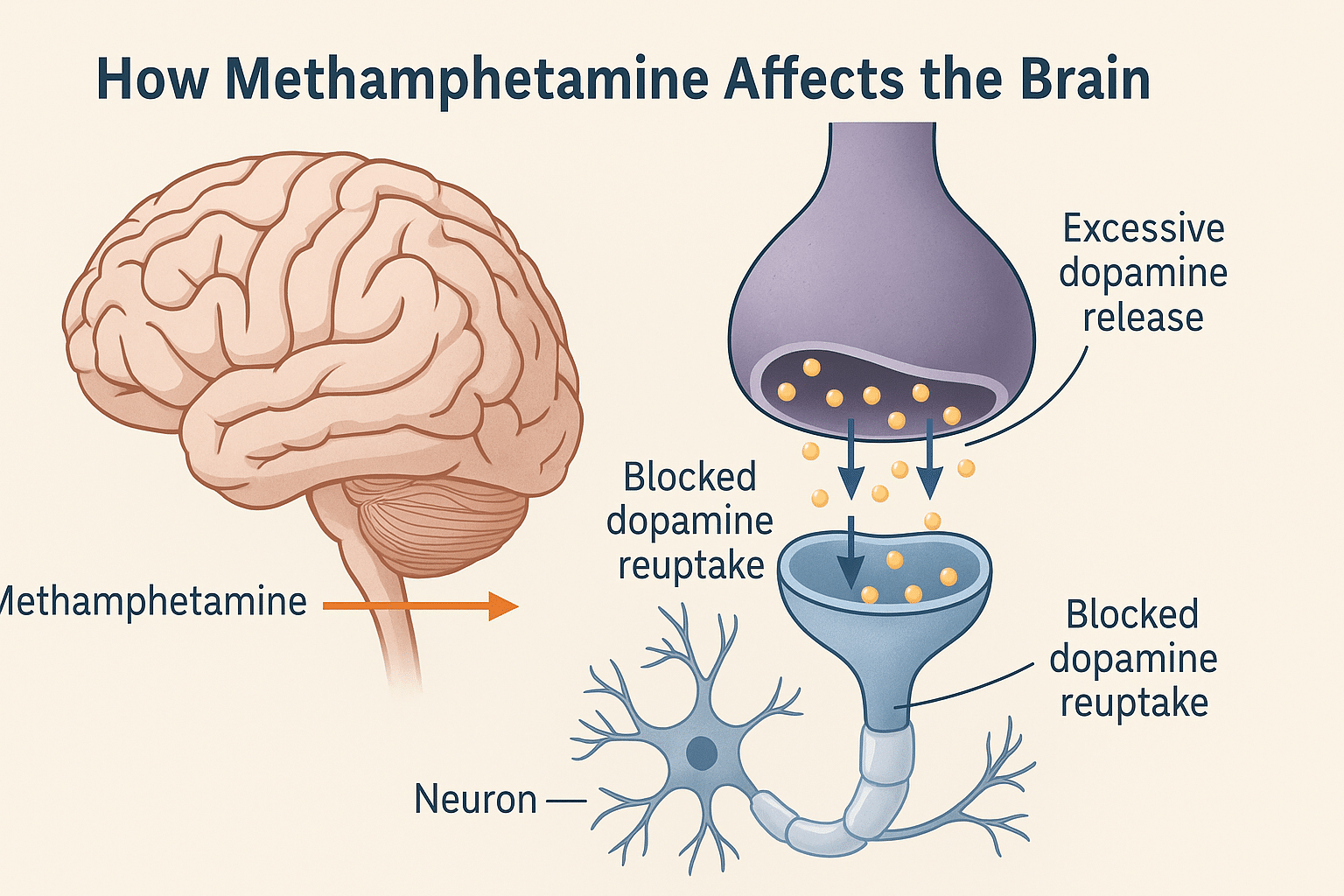Hello! Today, we’re going to talk about a very dangerous drug that’s unfortunately become more common, especially among young people. It’s called Methamphetamine, but you might have heard it called “Ice” or “Crystal Meth.” My goal here is to give you a clear understanding of just how dangerous this drug is, the harm it does to your body – especially your brain – and how you can get away from its grip if you or someone you know is caught up in it. Think of this as a straightforward conversation, where we’ll cover the facts.
What is Methamphetamine (“Ice” / Meth)?
Simply put, Methamphetamine is a powerful stimulant. This means it artificially revs up your body, making you feel wide awake, highly active, and less in need of sleep – but this is a deceptive feeling. This “boost” comes at an incredibly high and destructive cost.
This drug can come in different forms: pills, powder, or chunky crystals. Those crystals are what people commonly call “Ice” or “Crystal Meth.” This form is particularly popular among young adults and in the party or club scene, mainly because of the temporary, intense burst of energy it seems to offer.
What Are Other Names for “Ice”?
Methamphetamine goes by many street names. It’s important to know them so you can recognize what people are talking about if you hear these terms. Some common names include:
- Speed
- Uppers
- Meth
- Crystal Meth
- Chalk
- Ice
- Glass
- Crank (especially when injected)
No matter the name, the danger it poses is exactly the same.
How Do People Use “Ice”?
There are several ways people use Methamphetamine, and all ofthem are dangerous:
- Swallowed: In pill form.
- Snorted/Inhaled: As a powder, sniffed up the nose (sometimes called “bumping”).
- Smoked: The crystal form (“Ice”) is heated, and the vapors are inhaled.
- Injected: The drug is dissolved and injected directly into a vein.
Whichever method is used, the result is severe harm to both the body and mind.
What Happens to Your Body and Brain When You Use “Ice”?

This is the crucial part to understand. The temporary “good feeling” or “high” that “Ice” might offer is nothing compared to the massive, long-lasting damage it inflicts on your body, your brain, and your entire life.
The Deceptive Game “Ice” Plays Inside Your Brain: The “High” and the Start of Destruction
Our brain is an incredibly complex and amazing organ. It controls our feelings, thoughts, and actions through a network of chemical messengers called neurotransmitters. Think of these neurotransmitters as tiny mail carriers, delivering messages from one part of the brain to another.
One of the most important of these messengers is Dopamine. You can call Dopamine our “pleasure and reward messenger.” When we do something enjoyable, achieve a goal, or eat delicious food, Dopamine is released in the brain’s reward centers, making us feel happy and satisfied.
When a drug like “Ice” enters the body, it directly hijacks this Dopamine system. “Ice” causes a massive flood of Dopamine to be released throughout the brain – sometimes hundreds or even thousands of times more than normal! It’s like a Dopamine tsunami. Not only that, but “Ice” also blocks the normal process that reabsorbs Dopamine back into nerve cells (called reuptake).
So, can you imagine what happens when such a huge amount of Dopamine is suddenly active in the brain? That’s what causes the intense “high” or euphoria. For a short time, the person might feel on top of the world, incredibly energetic, and as if they have no problems at all. “Ice” also disrupts other important neurotransmitters like Norepinephrine (which controls alertness and energy) and Serotonin (which regulates mood, sleep, and appetite).
But this “game” is incredibly dangerous. When brain cells (neurons) are forced to work overtime like this, continuously, they can’t cope with the pressure.
- Neurotoxicity (Poisoning Nerve Cells): “Ice” is toxic to nerve cells. It directly damages the nerve endings that carry Dopamine and Serotonin messages. It’s like attacking those vital mail carriers.
- Crippling the Dopamine System: With continued “Ice” use, the brain’s ability to produce its own Dopamine decreases. The number of Dopamine receptors can also reduce. This means the person can no longer feel pleasure from normal, everyday things without the drug. Things that used to bring joy – like listening to music or laughing with a friend – feel flat and lifeless. Life can start to feel empty and bleak.
- Damage to Brain Structure: Long-term “Ice” use can damage parts of the brain responsible for memory, learning, and emotional control. Some brain cells can die, causing those brain areas to shrink. Think of it like a computer virus corrupting important files on your hard drive.
- Damage to Blood Vessels: “Ice” can damage the delicate blood vessels in the brain, increasing the risk of stroke.
So, that “high” comes from tricking the brain and disrupting its natural processes. The price paid for this deception is often permanent brain damage.
Dangerous Side Effects: What Happens to the Body
Using “Ice” can cause a range of immediate side effects, including:
- Rapid breathing
- Irregular heart rate
- Sudden increase in blood pressure
- Excessive sweating
- Severe headaches
- Blurred vision
- Dry mouth
- Hot flashes
- Dizziness
Additionally, “Ice” suppresses appetite, sometimes to the point where the user doesn’t feel hungry at all. Some people mistakenly think this is a good way to lose weight quickly. This is an incredibly dangerous and false idea. For example, imagine a young person, let’s call him Alex. Alex wants to fit in and maybe lose a bit of weight. He hears that ‘Ice’ can help with that and also give him energy. So, he starts using it. Initially, he might lose some weight and feel energetic at parties. But soon, all the side effects start kicking in: his heart races, he gets constant headaches, his vision blurs. Trying to lose weight this way, he ends up making his whole body sick. That’s the dangerous reality.
“Meth Mouth”: The Destruction of Teeth
Another severe problem for “Ice” users is a condition known as “Meth Mouth.” This involves severe tooth decay and gum disease, often causing teeth to crack, break, or fall out entirely. Sores can develop in the mouth, making it painful to talk or eat. It also significantly impacts a person’s appearance.
Long-Term Effects: A Life Turned Upside Down
The long-term damage to the brain from “Ice” use is profound. This can lead to:
- Memory problems, making it hard to remember things or learn new information. Imagine the memory center in your brain is like a library. Using “Ice” is like setting that library on fire. Some books (memories) are destroyed forever, and others become impossible to find.
- Problems with controlling body movements.
- Frequent mood swings. Someone who was happy one moment can become angry or sad the next, often for no reason.
- Violent behavior. For instance, someone who was previously calm and helpful, let’s call her Sarah, might become very argumentative and aggressive with family and friends after getting addicted to “Ice.” She might lash out over small things and become hurtful to others. Her entire personality can change, making life miserable for her and everyone around her.
Even Death from High Doses!
Taking a large dose of “Ice” can be fatal. The risks include:
- Dangerously high body temperature.
- Severe confusion and agitation.
- Convulsions (uncontrollable, jerking body movements).
- Ultimately, these conditions can worsen and lead to death.
Therefore, this is not something to experiment with, not even once.
Where Can You Find Help?
If you or someone you know is struggling with addiction to “Ice” or any drug, please remember that recovery is possible. Never think, “I can’t escape this.” Asking for help is not a sign of weakness; it’s the bravest and most important step you can take for yourself.
- Talk to your trusted healthcare provider (doctor, therapist, counselor). They can provide medical advice and guide you to mental health support.
- Many countries have dedicated services for drug addiction. Look for local health departments, community mental health services, or national helplines that offer counseling, support groups, and information on rehabilitation programs.
- Speak to a trusted adult you feel comfortable with – a parent, teacher, or family member. They can offer support and help you find the right resources.
- Remember, you are not alone. There are people who want to help you fight this.
In Conclusion…
“Ice” is a deadly trap that offers a fleeting illusion of pleasure but ends up destroying your entire life. Nothing it offers is worth the devastation it causes to your health, your dreams, and your loved ones.
So, I urge you, please never get involved with substances like this. Your life is precious. You have so much potential and so many wonderful things you can achieve. Drugs will only take all of that away.
If you or someone you know is facing this problem, please seek help. With the right support, it’s possible to overcome addiction and live a healthy, happy life. You deserve that.
Take care.


